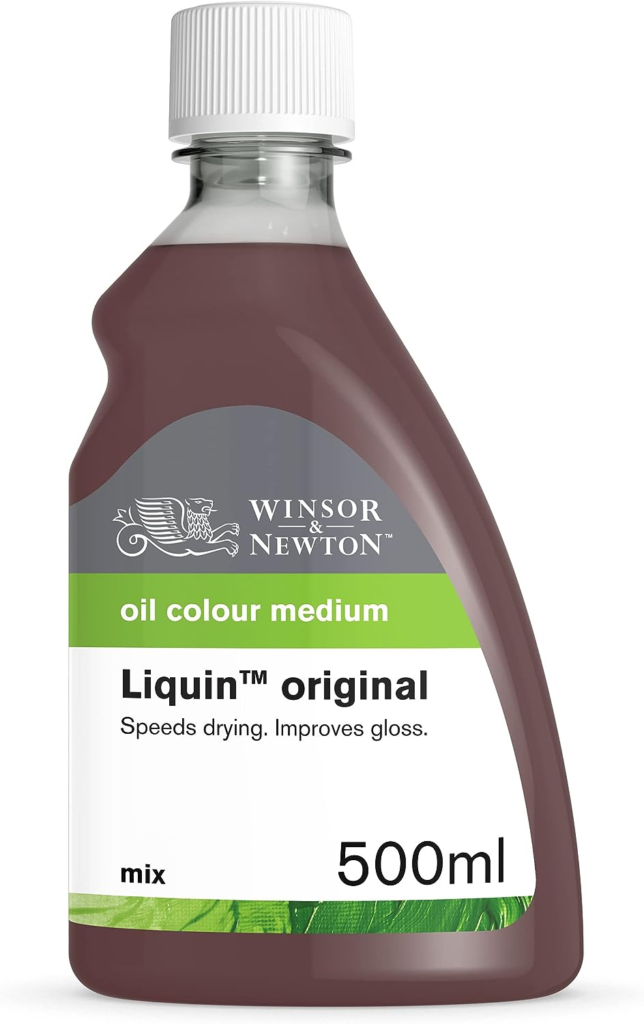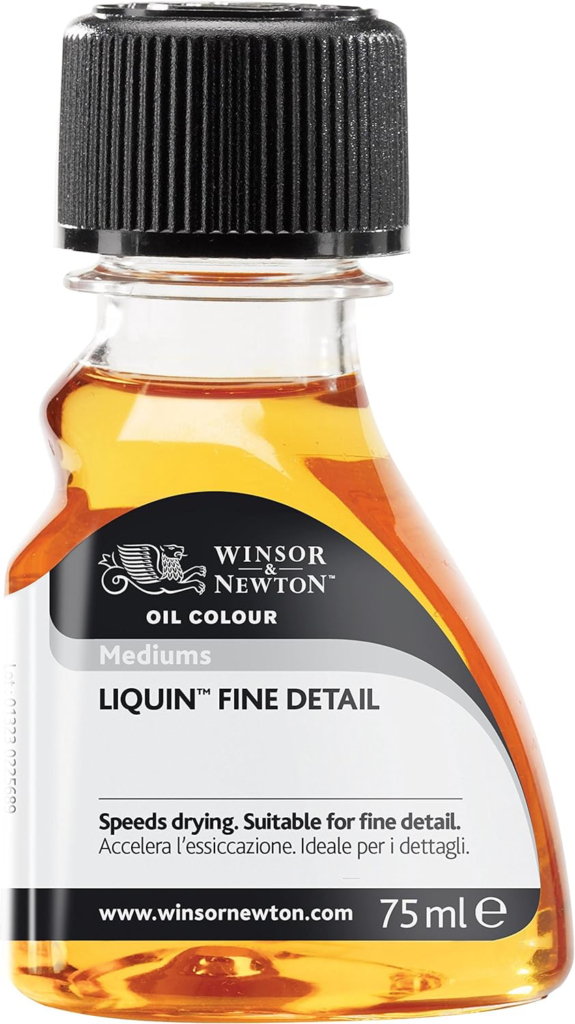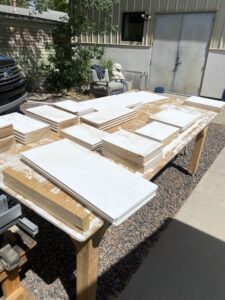Liquin Original, an alkyd resin medium, has become a trusted companion for many oil painters, myself included. Its versatility and ability to modify paint properties have earned it a special place in the art world. In this comprehensive guide, we will explore everything there is to know about Liquin, from its uses to application techniques, compatibility with other materials, and important considerations for safe and effective usage.
(I might include affiliate links in my posts! If you make a purchase through one of these links, it won’t cost you anything extra. You pay the same amount, but I earn a modest commission that supports the maintenance of this platform. Your support is greatly appreciated!)
What is Liquin?

Liquin is a brand of alkyd resin medium manufactured by Winsor & Newton, a respected name in art supplies. It’s used by all sorts of oil painters, enabling them to exert greater control over the characteristics of their oil paints.
It made its debut in the art world in 1970s when Winsor & Newton introduced it. This groundbreaking alkyd-based medium represented a significant departure from traditional oil painting mediums, such as linseed oil, due to its accelerated drying time.
Buy Liquin Original
Why Use Liquin?
Artists turn to Liquin for various reasons:
1. Speedy Drying: Liquin expedites the drying time of oil paints, making it an ideal choice for artists who desire shorter waiting periods between layers or for those working on tight schedules.
2. Enhanced Transparency: Depending on the formulation (e.g., Original or Fine Detail), Liquin can increase the transparency of oil paints, making it suitable for glazing and layering techniques.
3. Texture Control: Liquin can be employed to modify the texture of oil paints, allowing artists to achieve a range of effects, from smooth to impasto.
4. Sheen Variety: It can also be used to impart different surface sheens to paintings, ranging from glossy to satin finishes.
How to Use Liquin:
The application of Liquin is straightforward:
1. Mixing: Blend Liquin with oil paint on your palette in your preferred proportions. It is commonly used as a medium to dilute paint or as a glazing medium.
2. Layering: Apply layers of Liquin-modified paint over dried layers of oil paint to achieve various visual effects such as glazes.
3. Drying Time: Keep in mind that Liquin accelerates drying, so work quickly and adapt your technique accordingly.
Techniques with Liquin:
Liquin opens the door to numerous painting techniques:
1. Glazing: By adding Liquin to your oil paint, you can create translucent glazes that impart depth and luminosity to your work.
2. Impasto: Use Liquin to achieve impasto effects by mixing it with oil paint to create thick, textured layers. (see below for Liquin Impasto)
3. Wet-on-Wet: Liquin’s quick drying time is conducive to wet-on-wet techniques, allowing artists to blend colors seamlessly.
4. Blending: It facilitates smooth color blending and transition, enabling artists to achieve precise gradations and transitions in their artwork.
Is Liquin Suitable for Varnishing?
While Liquin is primarily used as a medium during the painting process, it is not generally recommended for varnishing. Artists typically opt for dedicated varnishes designed to protect and/or enhance the final appearance of their oil paintings.
A few reasons why you may not want to use Liquin as a varnish:
1. Durability and Yellowing: Over time, Liquin may not provide the long-term protection that a proper varnish can offer. Varnishes are designed to be durable, protecting the paint layers from dust, dirt, pollutants, and potential damage. They also contain UV inhibitors to help prevent fading. Liquin may not have these same protective properties, and its long-term effects on the paint layers are not as well-documented.
2. Reversible vs. Irreversible: Many varnishes used by artists are formulated to be reversible, meaning they can be removed without damaging the underlying paint layers. Liquin, once applied, is can’t be removed, and attempting to remove it could risk damaging the paint layers. But this is the reason why some artists like varnishing with Liquin, as it can’t removed, you can paint right on top of it in the future.
3. Gloss Consistency: Varnishes come in various finishes, from glossy to matte, allowing artists to choose the desired level of sheen for their artwork. Liquin may not provide the same range of options for achieving the desired gloss consistency.
4. Breathability: Oil paint takes a long time to dry, and if it’s not fully dry when you varnish with Liquin, it may never dry. Liquin seals the surface of the painting preventing the paint in the layers underneath to “breath” as others dedicated varnishes do. But if you used Liquin on the layers underneath, it is possible for those layers to be fully dry if you decide to varnish with Liquin, which again, it’s not recommended.
In summary, while Liquin is a valuable medium for modifying the properties of oil paints during the painting process, it is not a suitable substitute for a dedicated varnish when it comes to preserving, protecting, and enhancing a finished oil painting. To ensure the longevity and appearance of your artwork, it is recommended to use a professional artist-grade varnish designed for this specific purpose.
Potential Issues with Incorrect Usage:
When used improperly, Liquin can lead to some issues in oil paintings, including:
1. Over-thinning: Overly diluting your oil paint with Liquin can result in a loss of body and texture in your artwork.
2. Yellowing: Excessive use of Liquin in the painting process may contribute to yellowing over time.
3. Cracking: Applying thick layers of Liquin can cause surface cracking as it dries at a different rate than the paint.
Health Concerns and Toxicity:
Liquin is generally considered safe for artists when used as directed. However, like many art materials, should be handled with care due to potential health and toxicity concerns. Here are some key points regarding the health and safety considerations when using Liquin:
Ventilation – When working with Liquin, it’s essential to be in a well-ventilated area. This helps to minimize the inhalation of any fumes or vapors that may be released during use. Proper ventilation is crucial to maintain a safe working environment.
Skin Contact – Avoid direct contact with Liquin. Some formulations may contain solvents or chemicals that can be absorbed through the skin. It’s advisable to wear nitrile gloves to protect your hands from any potential irritation or absorption.
Ingestion – Liquin is not meant to be ingested. Always wash your hands thoroughly after handling Liquin, especially before eating or drinking.
Eye Protection – While painting, be cautious not to touch your face or eyes with paint-contaminated hands. If Liquin comes into contact with your eyes, rinse them thoroughly with water and seek medical attention if irritation persists.
Dispose of Waste Properly – Dispose of any waste, such as used rags or tissues, that may be contaminated with Liquin according to local regulations for hazardous materials. Do not dispose of them in regular household trash.
Safety Data Sheet (SDS) – Review the SDS provided by the manufacturer for the specific Liquin product you are using. It contains detailed information on the product’s composition, potential hazards, safe handling practices, and emergency procedures. You can review the Liquin SDS here
Allergies and Sensitivities – Some individuals may be more sensitive or allergic to certain art materials. If you experience any adverse reactions or discomfort while using Liquin, discontinue use and seek medical advice if necessary.
Alternatives – If you have concerns about the health and safety aspects of Liquin, consider exploring alternative oil painting mediums that may have fewer toxic components. Water-mixable oils, for example, offer a less toxic option for artists.
Always prioritize your safety when working with art materials. By following proper safety precautions and handling Liquin responsibly, you can enjoy your artistic endeavors while minimizing potential health risks.
Mixing Liquin with Other Mediums and Paint Brands:
Liquin is compatible with many oil painting mediums and solvents. However, it is advisable to follow recommended mixing ratios and conduct compatibility tests before applying them to your artwork. I sometimes like to mix liquin 50/50 with Gamsol for consistency reason.
Liquin serves to modify the properties of oil paint, affecting its drying time, transparency, texture, and sheen. The specific impact varies depending on the formulation of Liquin used (e.g., Original or Fine Detail).
It can be used with oil paints of any brand, making it a versatile choice for artists who use different paint manufacturers.
Are there other types of Liquin?
Winsor & Newton offers several types of Liquin, each tailored to different artistic needs and techniques. As of my last knowledge, here are some of the main Liquin products available other than the Liquid Original:

2. Liquin Fine Detail: Similar to Liquin Original, but with a slightly different formulation that is designed for fine detail work. It maintains brushstrokes and texture, making it ideal for intricate work.
Find Liquin Fine Detail SDS here
3. Liquin Impasto: This medium is specially formulated for impasto techniques, allowing artists

to create thick, textured layers in their oil paintings. It provides pronounced texture and bold sculptural effects.
This medium is specifically formulated to retain the texture and sculptural quality of impasto techniques. It allows artists to create thick, expressive strokes that remain prominent even as the paint dries.
Similar to other Liquin products, Liquin Impasto accelerates drying time, enabling artists to work in layers without having to wait extended periods between applications. It can be mixed with oil paints and other Liquin products. It is generally compatible with a variety of oil paint brands, making it a versatile choice for artists who use different materials
Artists appreciate Liquin Impasto for the way it enhances texture and surface quality. It can create pronounced ridges and peaks, adding an extra dimension to the artwork.
Find the Liquin Impasto SDS here
Buy Liquin Impasto
4. Liquin Oleopasto: Liquin Oleopasto is a semi-gel medium that combines the texture-enhancing properties of Liquin with a thicker consistency. It’s suitable for artists who want to achieve impasto texture while retaining translucency.

One of the key attributes of Liquin Oleopasto is its texture. It’s designed to thicken oil paint, making it an ideal choice for artists who prefer impasto techniques. This medium allows for the creation of thick, textured layers in your artwork, adding depth and dimension.
Like other Liquin products, Liquin Oleopasto accelerates drying time. However, because of its thicker consistency, the drying time may vary compared to regular Liquin. Artists should be mindful of this when working with it.
Liquin Oleopasto can be mixed with oil paints to achieve a range of effects, from translucent layers to thick impasto applications. The degree of transparency can be controlled by adjusting the ratio of medium to paint. It is compatible with other Liquin products and various oil paint brands, offering flexibility for artists who enjoy experimenting with different materials.
Find Liquin Oleopasto SDS here
Buy Liquin Oleopasto

5. Liquin Light Gel: Liquin Light Gel is designed for artists who prefer a lighter gel consistency. It speeds up drying and increases the flow of oil paints without adding much thickness. It’s particularly useful for artists who want to create smooth, flowing passages in their work.
Find Liquin Gel SDS here
Buy Liquin Light Gel
Liquin is a valuable tool in the arsenal of oil painters, offering control over drying times, texture, transparency, and sheen. Whether you’re an artist looking to expedite your creative process or enhance the visual qualities of your artwork, Liquin can be a trusted ally. By understanding its properties and using it correctly, you can harness its full potential and elevate your oil painting endeavors to new heights. Always remember to prioritize safety and follow recommended usage guidelines to ensure a seamless and enjoyable artistic journey.



